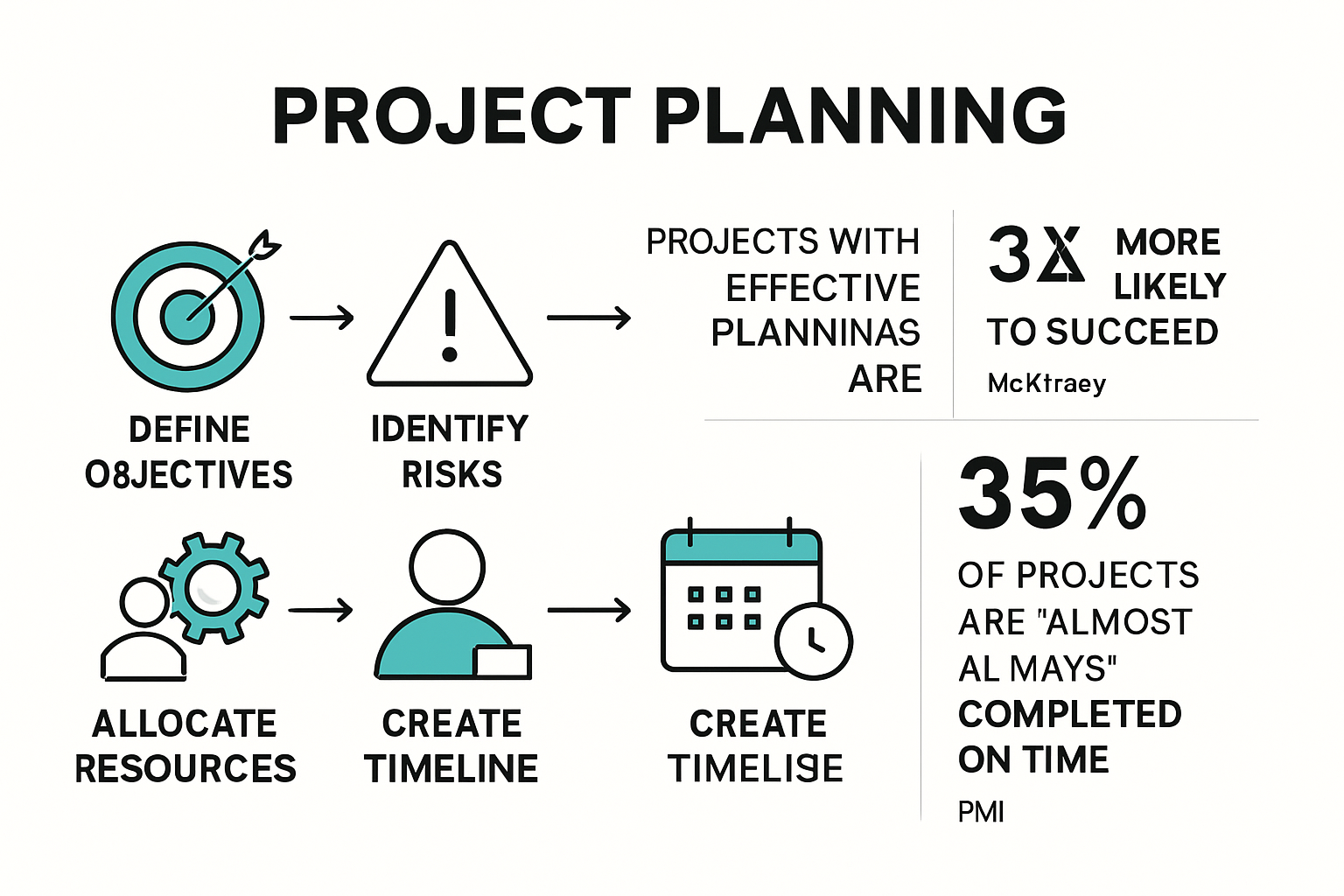Project planning shapes the outcome of every major initiative, yet most leaders do not realize just how much hinges on this phase. A full 62% of organizations report falling short on effective project planning. So why do so many teams struggle even with expensive tools and expert advice? The answer is not about working harder or following the same old routines. True success starts with a fresh approach that rewrites the rules entirely.
Table of Contents
- Understanding Key Project Planning Steps
- How To Apply Project Planning Steps In Your Team
- Common Challenges And Solutions In Project Planning
Quick Summary
| Takeaway | Explanation |
|---|---|
| Establish a strategic planning foundation | Effective project planning begins with clear objectives and risk identification, ensuring all resources are aligned with goals. |
| Create a collaborative planning culture | Promote open communication and shared accountability among team members to enhance planning success. |
| Utilize adaptable planning frameworks | Choose methodologies like Agile or Scrum that allow for flexibility and iterative adjustments based on project needs. |
| Proactively manage project risks | Identify potential barriers early and develop strategies to mitigate them, ensuring project continuity and success. |
| Leverage technology for effective planning | Use advanced tools and AI capabilities to enhance forecasting, resource allocation, and real-time collaboration within projects. |
Understanding Key Project Planning Steps
Successful project management hinges on mastering essential project planning steps that transform complex initiatives into achievable goals. Project planning is not simply about creating a roadmap but strategically aligning resources, expectations, and outcomes to drive organizational success.
The Strategic Foundation of Project Planning
Project planning serves as the critical blueprint for translating vision into reality. Understanding project management foundations reveals that effective planning goes beyond traditional task lists. According to McKinsey & Company, organizations that implement robust planning processes are 60% more likely to complete projects successfully.
The core of project planning involves several interconnected components. These include defining clear objectives, identifying potential risks, allocating resources strategically, establishing realistic timelines, and creating measurable milestones. Leaders must approach project planning as a dynamic process that requires continuous assessment and adaptation.
To help clarify these essential project planning components, the following summary table organizes the key steps leaders should focus on in the planning process:
| Planning Step | Description |
|---|---|
| Define Clear Objectives | Establish concrete, measurable project goals |
| Identify Potential Risks | Anticipate and document possible obstacles and uncertainties |
| Allocate Resources Strategically | Assign team members and assets based on project requirements |
| Establish Realistic Timelines | Create achievable schedules with built-in flexibility |
| Create Measurable Milestones | Set interim checkpoints for tracking progress and accountability |
Navigating Project Complexity Through Systematic Approaches
Modern project planning demands a multifaceted approach that accounts for organizational complexity. Successful leaders recognize that project planning steps are not linear but iterative and interconnected. This means continuously evaluating project parameters, team capabilities, technological constraints, and market dynamics.
Research from Project Management Institute indicates that projects with comprehensive planning frameworks are 45% more likely to meet their original goals. Key strategies include:
- Stakeholder Alignment: Ensuring all parties understand project vision and expectations
- Risk Management: Proactively identifying and mitigating potential challenges
- Resource Optimization: Matching team skills with project requirements
- Flexible Methodology: Adapting planning approaches to project unique characteristics
Leaders must develop a nuanced understanding of project planning that transcends traditional methodologies. This involves creating adaptable frameworks that can pivot quickly in response to emerging challenges or opportunities. Successful project planning is not about rigid adherence to a predetermined path but maintaining strategic flexibility while keeping core objectives in focus.
Technological advancements and evolving workplace dynamics continue to reshape project planning approaches. Artificial intelligence, data analytics, and collaborative platforms are enabling more sophisticated planning techniques that provide real time insights and predictive capabilities.
Ultimately, mastering project planning steps requires a combination of strategic thinking, technological understanding, and human insight. Leaders who can balance these elements will be best positioned to drive organizational success in an increasingly complex business environment.

How to Apply Project Planning Steps in Your Team
Transforming project planning from theoretical concept to practical implementation requires strategic team engagement and deliberate organizational practices. Successful application of project planning steps demands a holistic approach that integrates individual capabilities with collective team dynamics.
Creating a Collaborative Planning Environment
Effective project planning begins with establishing a collaborative culture that encourages transparent communication and shared accountability. Learn more about team collaboration techniques that enhance planning processes. According to Harvard Business Review, teams that prioritize open dialogue and collective goal setting are 70% more likely to achieve project success.
Key strategies for creating a collaborative planning environment include:
- Clear Communication Channels: Establish structured communication protocols
- Shared Vision Development: Ensure team members understand project objectives
- Regular Planning Sessions: Conduct periodic meetings to review and adjust plans
- Inclusive Decision Making: Involve team members in critical planning discussions
Implementing Practical Planning Frameworks
Technological tools and structured methodologies play a crucial role in practical project planning. Research from Project Management Institute reveals that organizations using structured planning frameworks experience 55% faster project completion rates.
Teams should focus on developing adaptable planning approaches that accommodate diverse project requirements. This involves selecting appropriate methodologies such as Agile, Scrum, or hybrid approaches tailored to specific organizational needs. The goal is to create a flexible framework that allows for iterative adjustments while maintaining clear strategic direction.
Leaders must invest in training and resources that enable team members to understand and effectively utilize project planning tools. This includes providing access to project management software, conducting regular skill development workshops, and creating documentation that outlines planning processes.
Successful project planning implementation requires continuous learning and adaptation. Teams must remain open to feedback, analyze past performance, and be willing to modify their approach based on emerging insights. By treating project planning as a dynamic process rather than a static procedure, organizations can develop more resilient and responsive project management capabilities.
Technology continues to transform project planning approaches. Artificial intelligence, machine learning, and advanced collaboration platforms are enabling more sophisticated planning techniques that provide real time insights and predictive capabilities. Teams that embrace these technological advancements will be better positioned to navigate complex project landscapes and deliver consistent results.
Common Challenges and Solutions in Project Planning
Project planning is a complex process fraught with potential obstacles that can derail even the most meticulously designed initiatives. Understanding these challenges and developing strategic solutions is crucial for leaders seeking to navigate the intricate landscape of project management.
Identifying and Mitigating Project Planning Barriers
Explore advanced task management strategies that address common planning challenges. According to Gartner Research, 62% of organizations struggle with consistent project planning effectiveness. The most prevalent challenges include resource constraints, communication breakdowns, and unrealistic expectation management.
Key challenges that leaders must proactively address include:
- Resource Misalignment: Balancing team capabilities with project requirements
- Scope Creep: Preventing uncontrolled expansion of project boundaries
- Communication Gaps: Ensuring clear and consistent information flow
- Risk Management: Anticipating and mitigating potential project disruptions
The following table summarizes common project planning challenges and corresponding solutions as discussed in the article, to help leaders address these effectively:
| Challenge | Solution |
|---|---|
| Resource Misalignment | Strategic resource allocation and matching team skills |
| Scope Creep | Clearly define project boundaries and objectives |
| Communication Gaps | Develop robust communication protocols |
| Risk Management | Proactively identify and mitigate risks |
| Unrealistic Expectations | Set achievable goals and realistic timelines |
Strategic Solutions for Effective Project Planning
Research from MIT Sloan Management Review reveals that organizations implementing comprehensive solution strategies can improve project success rates by up to 40%. This requires a multifaceted approach that combines technological tools, human insight, and adaptive methodologies.
Effective solutions involve developing robust communication protocols, implementing flexible planning frameworks, and creating comprehensive risk management strategies. Leaders must cultivate a proactive approach that anticipates potential challenges rather than simply reacting to them as they arise.
Technology plays a critical role in addressing project planning challenges. Advanced project management tools now offer AI-powered predictive analytics, real-time collaboration features, and sophisticated resource allocation algorithms. These technologies enable more accurate forecasting, improved communication, and more efficient resource management.
Psychological and organizational factors significantly impact project planning success. Teams must develop a culture of transparency, accountability, and continuous learning. This involves creating safe environments where team members can openly discuss challenges, share insights, and collaborate on problem-solving strategies.
The most successful organizations view project planning challenges as opportunities for growth and improvement. By developing adaptive mindsets, investing in team development, and leveraging advanced technological tools, leaders can transform potential obstacles into pathways for innovation and success.
Ultimately, mastering project planning requires a holistic approach that balances technical expertise, human insight, and strategic thinking. Leaders who can navigate the complex landscape of project challenges will be best positioned to drive organizational success in an increasingly dynamic business environment.

Frequently Asked Questions
What are the key steps involved in effective project planning?
Effective project planning involves defining clear objectives, identifying potential risks, allocating resources strategically, establishing realistic timelines, and creating measurable milestones.
How can leaders create a collaborative planning environment?
Leaders can foster a collaborative planning environment by establishing clear communication channels, developing a shared vision, conducting regular planning sessions, and involving team members in decision-making processes.
What methodologies can be utilized for adaptable project planning?
Utilizing methodologies such as Agile, Scrum, or hybrid approaches allows teams to be flexible and make iterative adjustments based on project needs and requirements.
What are common challenges in project planning, and how can they be addressed?
Common challenges include resource misalignment, scope creep, communication gaps, and unrealistic expectations. Solutions involve strategic resource allocation, clearly defining project boundaries, developing robust communication protocols, and setting realistic goals and timelines.
Transform Your Project Planning Into Real Results With Gammatica
Leaders know that even small mistakes in project planning can cause delays, wasted resources, and team frustration. You have worked hard to define clear objectives, develop collaborative strategies, and set realistic milestones, but you still worry about resource alignment, communication gaps, or scope creep derailing your success. This feeling is all too common for forward-thinking teams aiming for project success in 2025. The business world is moving fast, and you deserve a tool that helps you adapt and thrive instead of wasting precious hours on repetitive tasks or manual progress tracking.

See how Gammatica.com empowers you to put practical planning frameworks into action using AI-driven suggestions, real-time automation, and customizable workflows. You can boost your team’s focus and transparency with features like Kanban boards, integrated checklists, and automated task management. Ready to save up to 16 hours every week and eliminate project planning headaches? Visit Gammatica.com now and start building a smarter, more collaborative approach to every project. Your next successful project begins here.
Recommended
- Project Progress Tracking: Strategies for Success in 2025 | Gammatica
- How to Manage Tasks Effectively in 2025: Proven Strategies for Leaders | Gammatica
- Collaborative Decision Making for Leaders: Strategies for 2025 | Gammatica
- Automation for Small Businesses: Essential Strategies for 2025 | Gammatica



